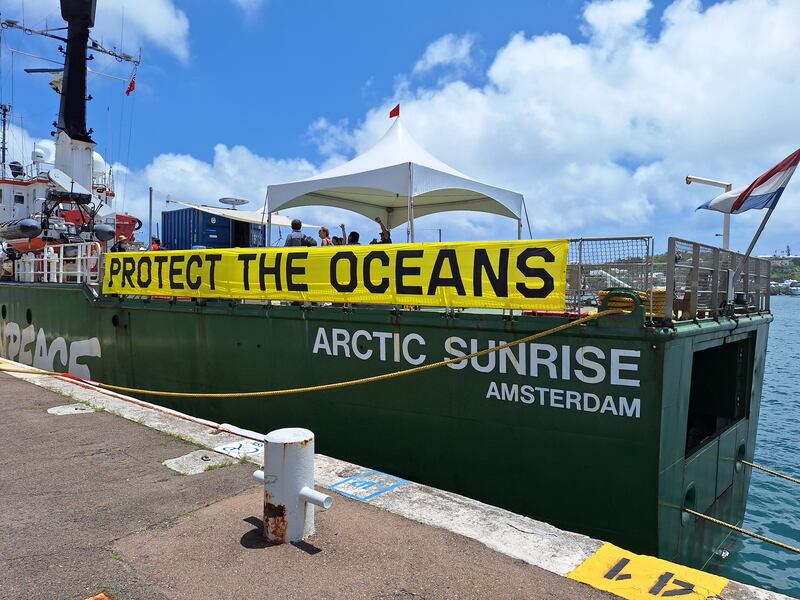BEST On Sargasso & UN High Seas Treaty
The Greenpeace International ship Arctic Sunrise visited Bermuda last month to campaign for ocean sanctuaries and the UN High Seas Treaty.
A spokesperson said, “Last month, in May, the Greenpeace International ship, the Arctic Sunrise, was in Bermuda as part of a global tour to campaign for ocean sanctuaries and to call for countries to urgently ratify the UN High Seas Treaty. This significant agreement moves us one step closer to achieving the globally agreed upon goal of protecting at least 30% of the world’s oceans by 2030.
“A member of the BEST board sailed with the ship on the leg from the Bahamas to Bermuda and others participated in a workshop in Bermuda to learn about how the new UN High Seas Treaty can be used to protect the unique biodiversity in the Sargasso Sea and to put Bermuda at the forefront of protecting the global ocean beyond our borders. See here for more information about the scope of the workshop.
“During a special trip into the Sargasso Sea, Greenpeace documented the mats [large masses] of Sargassum to see what species live in it, and, sadly, how much plastic waste ends up there. They collected over 300 pieces of plastic in just 30 minutes and pulled out abandoned fishing gear [known as ghost gear], with one net measuring approximately 80 metres in length – truly dangerous for all the wonderful species that call this region home.
“If the Sargasso Sea were properly protected under the Global Ocean Treaty, it would better safeguard the area against overfishing, pollution and shipping traffic, enabling species found there to thrive. What’s more, protecting the Sargasso could be the key to unlocking greater ocean protections all around the world.
“Greenpeace said that the discussions and insights shared with them while they were in Bermuda have made it clear that, together, we can make significant strides toward safeguarding our island’s precious marine environment, but further action is needed, and we hope you will join us in being a part of that action.
“Greenpeace International has prepared an open letter to the UK Foreign Secretary, urging that the protection of the high seas be prioritized, specifically the Sargasso Sea surrounding Bermuda. Your support by signing the letter would be significant in strengthening our call to action and would signal to the UK that Bermuda is united in our desire that they ratify the Treaty on our behalf.
“If you would like to review the letter and add your signature, please click here.
“Every voice counts and, together, we can advocate for meaningful change. Please help amplify the message by sharing this letter with others in your personal network, to broaden our collective impact in advocating for the protection of the Sargasso Sea.
“Thank you for your attention and participation in this important initiative.”
Read More About
Category: All, Environment



“If the Sargasso Sea were properly protected under the Global Ocean Treaty, it would better safeguard the area against overfishing, pollution and shipping traffic, enabling species found there to thrive.”
Please, Greenpeace Spokesperson, (why do we never know their names?) do remind everyone again as to what EXACTLY are the nebulous boundaries of the Sargasso Sea. Do mention that your vessel is powered by evil fossil fuels and that Greenpeace uses many of the 6,000 or so products derived from petroleum.
The goal of any green treaty such as the Global Ocean Treaty, is to restrict economic development and figure out new ways to tax people and businesses. For example, an Ocean Tax for cruise ships for being on an ocean. A Sargasso Sea tax for passing through the Sargasso Sea. Or let’s call the tax a “user fee,” so it can be said no taxes are being levied.
An oldie but goodie: Statement of Patrick Moore, Ph.D. Before the Senate Environment and Public Works Committee, Subcommittee on Oversight February 25, 2014
“In 1971, as a PhD student in ecology I joined an activist group in a church basement in Vancouver Canada and sailed on a small boat across the Pacific to protest US Hydrogen bomb testing in Alaska. We became Greenpeace.
After 15 years in the top committee I had to leave as Greenpeace took a sharp turn to the political left, and began to adopt policies that I could not accept from my scientific perspective.”